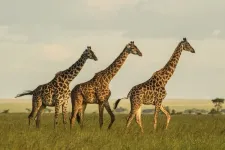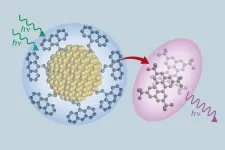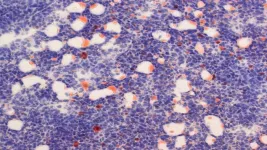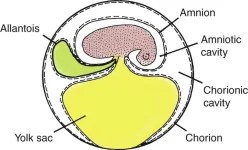(Press-News.org) UNIVERSITY PARK, Pa. — Giraffes in eastern Africa may be even more endangered than previously thought. A new study led by researchers at Penn State reveals that populations of Masai giraffes separated geographically by the Great Rift Valley have not interbred — or exchanged genetic material — in more than a thousand years, and in some cases hundreds of thousands of years. The researchers recommend that the two populations be considered separately for conservation purposes, with separate but coordinated conservation efforts to manage each population.
Populations of giraffes have declined rapidly in the last thirty years, with fewer than 100,000 individuals remaining worldwide. Numbers of Masai giraffes, a species found in Tanzania and southern Kenya that are considered endangered by the International Union for Conservation of Nature (IUCN) have declined by about 50% in this period due to illegal hunting and other human activities that encroach on their habitat, with only about 35,000 individuals remaining.
“The habitat of Masai giraffes is highly fragmented, in part due to the rapid expansion of the human population in east Africa in the last 30 years and the consequent loss of wildlife habitats,” said Douglas Cavener, Dorothy Foehr Huck and J. Lloyd Huck Distinguished Chair in Evolutionary Genetics and professor of biology at Penn State and leader of the research team. “Additionally, the Great Rift Valley cuts down through East Africa, and the steep slopes of its escarpments are formidable barriers to wildlife migration. We looked at the genomes of 100 Masai giraffes to determine if populations on either side of the rift have crossed over to breed with each other in the recent past, which has important implications for conservation.”
According to the researchers, giraffes are notoriously bad climbers. Using high-resolution satellite data, they found only two locations where the angle of the rift’s slopes was shallow enough for giraffes to potentially climb over, but there are no reports of them actually doing so. To better understand the historical exchange of genetic information, the researchers used a combination of whole genome sequencing of the nuclear genome, which includes genetic information passed on from both parents, as well the mitochondrial genome, which includes information passed on only from the maternal line. They present their results in a paper appearing July 12 in the journal Ecology and Evolution.
“Interbreeding among different populations results in the exchange of genetic information—often called gene flow—and is generally considered to be beneficial because it can improve overall genetic diversity and help buffer small populations against disease and other threats,” said Lan Wu-Cavener, assistant research professor of biology and a member of the research team. “To understand potential gene flow across the rift, we sequenced the more than 2 billion base pairs that make up entire nuclear genome as well as the more than 16,000 base pairs that make up the entire mitochondrial genome. This complex data presented a variety of computational and data storage challenges for our small team, but using the entire genome instead of a small portion allowed us to definitively investigate the extent of gene flow among these populations.”
The researchers identified several blocks of genes within the mitochondrial genome that are typically inherited together — which researchers call haplotypes — across the two populations and conducted a network analysis based on patterns of similarity across those haplotypes. They found that giraffes on the east side of the rift had no overlapping haplotypes with giraffes on the west side of the rift, which suggests that females have not migrated across the rift to breed in the past 250,000-300,000 years.
“Female-mediated gene flow between the two populations has not occurred in hundreds of thousands of years, or probably ever,” said Cavener. “This raised a new question that we hadn’t anticipated about the origin of these populations. We originally thought that one population was founded and then some individuals crossed over to the other side of the rift to establish the second population. But we now think that the two populations were founded independently more than 200,000 years ago.”
Analysis of the nuclear genome suggests that gene flow through the movement of males may have occurred as recently as a thousand years ago. The researchers plan to take samples from additional animals from both populations to better understand when and why this gene flow might have stopped.
“Taken together, these results suggest that populations of giraffes on each side of the rift are genetically distinct, with each population having less genetic diversity than if they were one, larger interconnected population,” said Cavener. “There are very little prospects of giraffes crossing over the rift on their own, and translocation is highly impractical with giraffes. This suggests that Masai giraffes are more endangered than we previously thought, and that conservation efforts for each population should be considered in an independent but coordinated fashion. We hope that the Tanzanian and Kenyan governments will increase the protection of Masai giraffes and their habitats, especially given the recent increase in giraffe poaching in the area.”
The researchers also found alarmingly high indicators of inbreeding — a process that decreases genetic diversity and overall fitness of the population — on both the east and west side of the rift. The researchers plan to continue to study populations of Masai giraffes on both sides of the rift, including those that are particularly isolated, to better understand any danger faced due to inbreeding. They also plan to investigate how giraffes move between groups on the east side of the rift, where the habitat is particularly fragmented, to better understand how to prioritize conservation efforts to maintain connectivity between them.
“We would also like to use genetics to clarify parental and sibling relationships in Masai giraffes,” said Cavener. “There’s a lot we don’t know about how giraffes mate, for example do only a few males successfully breed in a local population over many years or do several males breed in that population? These questions are critically important to estimating the actual breeding population of the populations and will continue to guide our efforts to protect and conserve these majestic and charismatic animals.”
In addition to Cavener and Wu-Cavener, the research team at Penn State includes first author George Lohay, postdoctoral scholar who collected the biological samples from wild giraffe in Tanzania; Associate Research Professor of Biology Derek Lee and academic affiliate in biology Monica Bond, whose work over the past decade on the Masai giraffe populations in this study were essential for the project design and interpretation of the results; undergraduate student David Pearce; and graduate student Xiaoyi Hou, This work was supported by the Penn State Department of Biology, the Eberly College of Science, and the Huck Institutes of the Life Sciences as well as the Wild Nature Institute.
END
Masai giraffes more endangered than previously thought
Giraffe populations separated by Great Rift Valley in eastern Africa are genetically distinct, suggesting that conservation efforts should be considered separately for each population.
2023-06-12
ELSE PRESS RELEASES FROM THIS DATE:
WVU research shows how much pharmaceutical companies are capitalizing on rare drug incentives
2023-06-12
Drugs used to treat rare conditions are earning pharmaceutical companies almost as much as those marketed to the general public, according to a researcher at West Virginia University. Sean Tu, a College of Law professor found lucrative so-called “orphan” drugs earn manufacturing tax credits, have longer patent exclusivities and face easier Food and Drug Administration review.
Orphan drugs treat diseases that affect fewer than 200,000 Americans. In addition to tax credits, Congress has incentivized the pharmaceutical companies that manufacture orphan drugs with a waiver of ...
Planet orbiting 2 stars discovered using new technique
2023-06-12
COLUMBUS, Ohio – An international team of astronomers is the first to apply an old technique to discover a new type of planet that orbits two stars – what is known as a circumbinary planet.
As an added bonus, researchers found a second planet that is orbiting the same two stars, which is only the second confirmed multi-planet circumbinary system found to date. The study was published today in the journal Nature Astronomy.
Circumbinary planets were once relegated to only science fiction, but thanks to data collected from NASA’s Kepler mission, astronomers now know that multiple star systems are ...
Railways could be a key 'utility player' for backup power
2023-06-12
– By Christina Nunez
The U.S. electric grid faces simultaneous, evolving pressures. Demand for power from the grid is increasing as people adopt electric cars and building energy is transitioned from gas to electricity. At the same time, climate change is driving more extreme weather. Events like the 2020 heat wave that led to rolling blackouts in California are relatively infrequent, but they are happening more often – and utilities need to be ready for them.
New research points to a flexible, cost-effective option for backup power when trouble strikes: batteries aboard trains. A study from the U.S. Department of Energy’s Lawrence Berkeley National Laboratory ...
Hines studying male victims of intimate partner violence in racial/ethnic minority communities
2023-06-12
Denise Hines, Associate Professor, Social Work, received funding for the study: "Understanding Male Intimate Partner Violence Victims from Racial/Ethnic Minority Communities."
Hines will lead a four-phase study on the experiences of male victims of intimate partner violence, with a specific focus on men from racial/ethnic minority communities.
She will conduct the study in four, simultaneous phases.
In Phase 1, Hines will conduct a survey study of male Intimate Partner Violence (IPV) victims, including 300 White men, 300 Black men, and 600 Latino men from both immigrant and non-immigrant communities within the United States. The survey will ...
Becker receives funding for scientific support in solar physics
2023-06-12
Peter Becker, Professor of Astrophysics and Space Sciences, received funding for: "Scientific Support in Solar Physics, Remote Sensing, Space Weather, High-Energy Astrophysics, and Associated Scientific Fields."
As part of this project, Mason researchers will conduct research in collaboration with the Naval Research Laboratory (NRL).
Areas covered by this research include: space sciences research (encompassing solar physics and studies of the integrated Sun-Earth system); computational physics and computational fluid dynamics; high-energy astrophysics; instrumentation ...
Baldimtsi conducting collaborative research focused on cryptographic accumulators and revocation of credentials
2023-06-12
Foteini Baldimtsi, Assistant Professor, Computer Science, received funding from the National Science Foundation for the project: "Collaborative Research: SaTC: CORE: Medium: Cryptographic accumulators and revocation of credentials."
The goal of the project is to design efficient revocation mechanisms for the Web PKI and beyond.
Baldimtsi and her collaborators will tailor cryptographic accumulators to the problem of credential revocation making certificate revocation mechanisms ...
Mason researchers receive funding for collaborative mobile immersive computing research infrastructure for multi-user XR
2023-06-12
Four Mason researchers received funding from the National Science Foundation for the project: "Collaborative Research: CCRI: New: CoMIC: A Collaborative Mobile Immersive Computing Research Infrastructure for Multi-user XR."
Bo Han, Associate Professor, Computer Science; Parth Pathak, Assistant Professor, Computer Science; Lap-Fai (Craig) Yu, Associate Professor, Computer Science; and Songqing Chen, Professor, Computer Science, are designing and developing the infrastructure for Collaborative ...
New material transforms light, creating new possibilities for sensors
2023-06-12
A group of scientists and engineers that includes researchers from The University of Texas at Austin have created a new class of materials that can absorb low energy light and transform it into higher energy light. The new material is composed of ultra-small silicon nanoparticles and organic molecules closely related to ones utilized in OLED TVs. This new composite efficiently moves electrons between its organic and inorganic components, with applications for more efficient solar panels, more accurate medical imaging and better night vision goggles.
The material is described in a new paper in Nature Chemistry.
“This process gives us a whole new way of designing ...
The latest weapon against cancer is … a keto diet?
2023-06-12
Dietitians say a keto diet could help you lose up to 10% of your body weight. These high-fat, low-carb meal plans trick the body into burning its own fat. They could also help fight a variety of cancers by starving tumors of the glucose they need to grow. On the surface, this seems ideal. But research suggests these diets may have a deadly, unintended side effect for cancer patients.
In mice with pancreatic and colorectal cancer, keto accelerates a lethal wasting disease called cachexia. Patients and mice with cachexia experience loss of appetite, extreme weight loss, fatigue, and immune suppression. The disease has no effective treatment and contributes to about 2 million ...
Which came first: the reptile or the egg?
2023-06-12
The earliest reptiles, birds and mammals may have borne live young, researchers from Nanjing University and University of Bristol have revealed.
Until now, the hard-shelled egg was thought to be the key to the success of the amniotes - a group of vertebrates that undergo embryonic or foetal development within an amnion, a protective membrane inside the egg.
However, a fresh study of 51 fossil species and 29 living species which could be categorised as oviparous (laying hard or soft-shelled eggs) or viviparous (giving birth to live young) suggests otherwise.
The findings, published today in Nature Ecology & Evolution, show that all the great evolutionary branches ...
LAST 30 PRESS RELEASES:
Automatic label checking: The missing step in making reliable medical AI
Low daily alcohol intake linked to 50% heightened mouth cancer risk in India
American Meteorological Society announces Rick Spinrad as 2026 President-Elect
Biomass-based carbon capture spotlighted in newly released global climate webinar recording
Illuminating invisible nano pollutants: advanced bioimaging tracks the full journey of emerging nanoscale contaminants in living systems
How does age affect recovery from spinal cord injury?
Novel AI tool offers prognosis for patients with head and neck cancer
Fathers’ microplastic exposure tied to their children’s metabolic problems
Research validates laboratory model for studying high-grade serous ovarian cancer
SIR 2026 delivers transformative breakthroughs in minimally invasive medicine to improve patient care
Stem Cell Reports most downloaded papers of 2025 highlight the breadth and impact of stem cell research
Oxford-led study estimates NHS spends around 3% of its primary and secondary care budget on the health impacts of heat and cold in England
A researcher’s long quest leads to a smart composite breakthrough
Urban wild bees act as “microbial sensors” of city health.
New study finds where you live affects recovery after a hip fracture
Forecasting the impact of fully automated vehicle adoption on US road traffic injuries
Alcohol-related hospitalizations from 2016 to 2022
Semaglutide and hospitalizations in patients with obesity and established cardiovascular disease
Researchers ‘listen in’ to embryo-mother interactions during implantation using a culture system replicating the womb lining
How changing your diet could help save the world
How to make AI truly scalable and reliable for real-time traffic assignment?
Beyond fragmented markets: A new framework for efficient and stable ride-pooling
Can shape priors make road perception more reliable for autonomous driving?
AI tracks nearly 100 years of aging research, revealing key trends and gaps
Innovative techniques enable Italy’s first imaging of individual trapped atoms
KIER successfully develops Korea-made “calibration thermoelectric module” for measuring thermoelectric device performance
Diversifying US Midwest farming for stability and resilience
Emphasizing immigrants’ deservingness shifts attitudes
Japanese eels, climate change, and river temperature
Pusan National University researchers discover faster, smarter heat treatment for lightweight magnesium metals
[Press-News.org] Masai giraffes more endangered than previously thoughtGiraffe populations separated by Great Rift Valley in eastern Africa are genetically distinct, suggesting that conservation efforts should be considered separately for each population.





